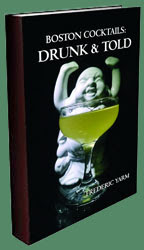
With Tales being a month away, I figured it was time to share some tips in plenty of time to go shopping as well as physically and mentally prepare for the hustle. At the end of Tales last year, besides making a list of the
best moments, I also jotted down some bits of advice to remember for myself and for passing on to future Tales goers. I will save the standard "drink a lot of water," "remember to eat and sleep,"and other basic life functions to other blogs who have done it so well in the past and will probably do again in the future. If you need to read or re-read that advice,
here is a great one written by LUPEC Boston's own Kitty.
First, keep in mind that Tales is a multi-ring circus with a lot going on in tasting rooms, seminars, official events, unofficial and ambush marketing ones, and restaurants, bars, and music halls across the city. Trying to do a little of everything, but not trying to do everything, is key. Being too focused on seminars, for example, will cause you to miss out on the tasting rooms going on at the same time. Running around from one place to another in a hurry might cause you to miss out on meeting some interesting and valuable people. Moreover, becoming too focused on Tales events might make you miss what the city itself has to offer (unless of course, you go down to New Orleans other times of the year). Know that there is a world outside of the Monteleone; however, if you do get trapped at the Carousel Bar, remember that you can keep track of how long you have been there by how many disorienting
revolutions you have made. Overall, find your rhythm, find your pace. If you discover yourself overexerted, take a break in your hotel room or pool or perhaps take the next day easy. If you can handle the rush, remember that there will be a chance to decompress at the end of the week. And taking an extra day in New Orleans after Tales to recover is not a bad idea either.
Despite my advice to diversify, having a specific goal at Tales can help make things fun. A few come to mind. Devin of the
Periodista Tales went in search of people who could provide him history about the drink recipe he was researching; this brought him face-to-face with a lot of famous cocktail historians with a good focus point (or excuse) to do so. Andrea of this blog had a project to learn what she could about New England Rum; this scored us an
invitation to a private rum tasting where we actually got to taste some rather old New England Rum made a few miles from our house as well as some other amazing spirits. Another noteworthy quest was undertaken by Camper English of
Alcademics who set out to live tweet every drink he had a Tales that week. Perhaps trying as many different establishments' Sazeracs, Vieux Carrés, or Pimm's Cups? Trying to see how many nips of booze you can gather at tasting rooms to smuggle back home without exceeding your airline's luggage weight limit? Be creative and have some fun doing so.
With all that variety, keep in mind that people are there for very different reasons with sometimes a lot of overlap and sometimes very little. Finding out how you can learn from another or help them out is often worthwhile. And sometimes, you realize that you have no common overlapping interest, so move on without a second thought. Furthermore, do not feel afraid to talk to people who you think are really famous or important. Very few of the people you want to meet in the cocktail world have attitudes. The few that do could be because you caught them when they were really tired, overstressed, or other. True, there are a small fraction who do not fall into those categories and do not comprehend the cordial and collegiate atmosphere of the event; if you need revenge to assuage your anger, making up and spreading rumors that you spotted them late at night walking in or out of Hustler's Barely Legal on Bourbon Street might be okay. In some cases, you will not even need to make it up.

In terms of networking, getting business cards printed up is key and there is still time; I highly recommend
VistaPrint but plenty of other online and local establishments can provide you a stack of cards in the next few weeks. It saves you from finding paper or mustering up enough sobriety to produce legible penmanship, and it makes exchanging contact information a snap. But wait? What happens at the end of Tales when you end up with a stack of cards you do not recall receiving? My advice is to write a short note on each card you receive that will help you trigger a memory of who this person was and/or why you should contact or remember this person in the future. Notes like "girl in the purple dress at the XYZ event" and "email later about this product" will help make sense of your stack of odds and ends once the dust settles and the fog lifts. Lastly, make a point of writing thank yous to the people you met at Tales. You now have their business cards and they might be as hazy as to what you spoke about as you would be had you not written that short reminder note on their card. Taking a few minutes per potentially valuable contact to reconnect in a calmer, less booze-influenced moment a week or two later can solidify interactions. I did this the first year we went to Tales and I regret getting too busy to do so after last year's trip.
While I said that I was not going to give basic life advice, there are few things worth pointing out. New Orleans weather is extreme. It can go from hot and sunny to dark and stormy on a moment's notice. Carrying a portable umbrella and wearing a hat to keep sun and rain away are good ideas. Last year was not too rainy but the year before had torrential downfalls that made us seek shelter in stores or under overhangs. Moreover, New Orleans is a walking city so bring sensible shoes; Andrea adds that you should bring fast drying socks and shoes for the deluges you seem inevitably to get caught in. There are plenty of taxis and cheap street trolleys for longer distances or for safety's sake. Some people have commented that New Orleans is not that safe of a town, but if you walk with a purpose (even if you do not really have one), you will not seem like an easy target.
New Orleans is filled with great restaurants. One thing we learned is not to be surprised with slow service. Things work on a different pace there. Often, it seemed like a test -- after a slow period of ignoring us, they get things moving and become really friendly perhaps because we did not complain. This happened on more than one occasion and the result of our patience was great treatment in the latter half of each experience. Some of our best restaurant recommendations came during these moments.
Lastly, New Orleans allows for open containers. Sure, you will have plenty of booze at the tasting rooms, seminars, bars, and events, but do not neglect a chance to drink on the street. In a rush to leave, ask for a go-cup for the rest of your drink or for one for the road. And street beer? Yes, please. When stopping in to a store for a fine Belgian or other, some establishments will ask if you want the bottle opened right then and there. Whether it is a hot July day where some suds will help quench the heat or a balmy evening where a nightcap brew will help make the walk home pass by easier, a good beer can be your friend. Do not neglect the local Abita Brewery while you are down there for the cocktails; they make some fine product worth sampling.
Soon, I will do another
vegetarian dining in New Orleans post, but until then, start organizing your trip for the less obvious things than airline, hotel, and event tickets. Purchasing spare smart phone batteries (and a battery charger), larger memory cards for your camera, and the like still need to be done. And even if they do not, things always seem to work out.








 MxMo LIX: Beer!
MxMo LIX: Beer!






 I always think about the egg white-laden recipe I avoided back in the day. David Wondrich on the
I always think about the egg white-laden recipe I avoided back in the day. David Wondrich on the 

 With Tales being a month away, I figured it was time to share some tips in plenty of time to go shopping as well as physically and mentally prepare for the hustle. At the end of Tales last year, besides making a list of the
With Tales being a month away, I figured it was time to share some tips in plenty of time to go shopping as well as physically and mentally prepare for the hustle. At the end of Tales last year, besides making a list of the 






 1 1/2 oz Tequila Ocho Reposado
1 1/2 oz Tequila Ocho Reposado


 The theme for this month's
The theme for this month's 














 The 2017 collection of 855 drink recipes, bartender tributes, and essays on hospitality from CocktailVirgin's Frederic Yarm. Available at
The 2017 collection of 855 drink recipes, bartender tributes, and essays on hospitality from CocktailVirgin's Frederic Yarm. Available at  The 2012 collection of 505 drink recipes, techniques, and Boston bar recommendations from Frederic Yarm. Available at
The 2012 collection of 505 drink recipes, techniques, and Boston bar recommendations from Frederic Yarm. Available at 



